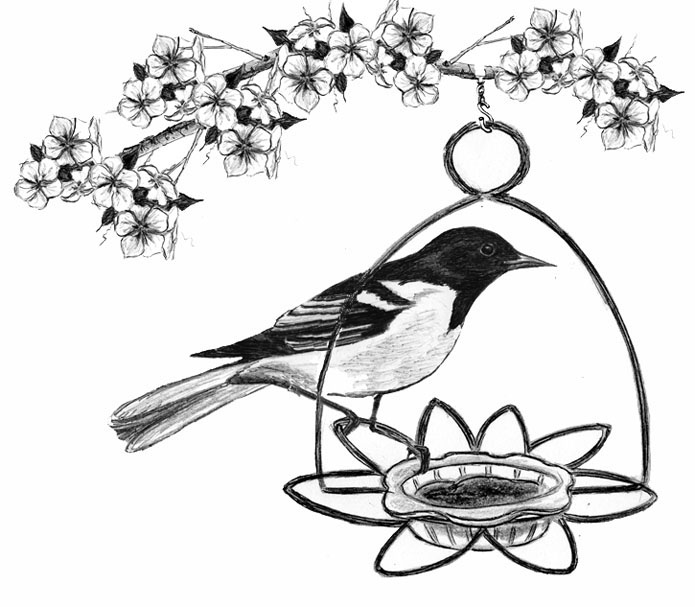
Dear Bird Folks,
We are currently enjoying the orioles that are coming to our friend’s feeder here on Cape Cod. If we put out an oriole feeder when we get home next week, do you think we will also attract them, or is it too late for this year?
– Marsha, Albany, NY
First, I have a question for you, Marsha,
Which city do rabbits like the best? A six-year-old girl once asked me this question (in order to win a pencil) and I didn’t know the answer. Do you know? Well, you should. A rabbit’s favorite city is…Albany. Get it? “All-bunny.” Don’t groan at me if you didn’t like the joke. You can take it up with the little girl. But I loved it. In fact, I not only gave her a pencil, but I also offered her a job. She starts on Tuesday, August 29th…2029. (I only hope that between now and then she learns something about birds because we don’t have a bunny department.)
One of the best months to attract Baltimore Orioles is May, when the hungry birds are returning from the tropics. In May we see two different populations of orioles. There are the birds that have returned to our area to breed and there are also the migrants that only stop here to refuel on their way farther north. After May comes the month of June (in case you didn’t know), and this is one of the toughest months to get orioles. By June the migration is over and the nesting birds have settled into their territories, which may or may not be near your yard. Folks now wonder why the orioles have suddenly “disappeared.” I assure everyone that they haven’t disappeared, but are just busy with their nesting chores. We have to sit tight because in a few weeks there will be tons of orioles around. Why is that, you ask? It is because the adult orioles have all just had lots of babies. Perhaps not as many babies as bunnies have, but still quite a few.
After the breeding season the female oriole takes a break from child rearing and drifts away to begin her annual molt. The kids are left in the capable hands (or wings) of the male. It’s dad’s job to stay with the young birds for a few more weeks in order to teach them the ancient oriole ways. My own feeder has followed the above scenario to the letter. In May we had lots of orioles, but not a single one in June. Then by late July they were back. Just today my feeder played host to four squabbling young orioles, plus one very handsome male, and he had no patience for his bickering offspring. The rowdy kids took turns pushing each other off the feeder, but they all backed away the minute their old man arrived, which is the way it should be.
When it comes to feeding orioles, the most popular food options are orange halves, sugar water, and grape jelly. Back in the ‘70s we all set out oranges and the birds came to them quite regularly. Then someone noticed that orioles were also drinking from hummingbird feeders, so oriole-friendly sugar water feeders were invented. More recently, grape jelly has become fashionable. (I don’t really know who started offering the birds jelly, but I’ll bet it was one of the Smucker boys.) This is too bad because of the three choices, jelly is by far the most expensive…and that’s before adding the peanut butter. (That last line was a joke. You won’t improve your odds of seeing orioles by offering them both peanut butter and jelly, although you may attract lots of hungry school children…and me.)
As jelly becomes more popular, there has been some concern about whether it’s healthy for the birds. I was one of these concerned people myself. So, in order to ease my conscience, I spoke to several wildlife rehabilitators about this topic and none of them believed jelly was harmful. In addition, I have one customer who has perhaps half a dozen nesting orioles (and counting) in her yard and for years the birds have been happily coming to her jelly feeders. Combine this with the news that the Massachusetts breeding population of orioles appears to be on the increase and it makes me think that the jelly thing is probably okay. This is good news for the Smucker boys and it should help them forget about their whacky name.
I say go for it, Marsha. I don’t see any reason why you shouldn’t put out an oriole feeder when you get back to Albany. There’s still time. Between the local breeding birds and the migrants, we tend to see orioles until the end of September. Besides, if you buy your feeder now, you’ll be sure to have it on hand when the orioles return next May (if you can remember where you put it over the winter).
On a different topic:
We are now in the middle of “bald bird season.” For reasons that aren’t entirely clear, some birds, in particular Blue Jays and cardinals, totally lose their head feathers this time of year. We see cardinals with featherless black heads and pinheaded Blue Jays. But not to worry; this is associated with their annual molt. The lost feathers will eventually grow back. However, in the meantime the birds will look silly and in desperate need of a hat. (Hey, I think I just got an idea for a new product.)